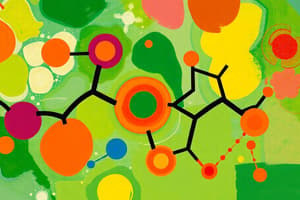Podcast
Questions and Answers
What is the first step in the degradation of amino acids?
What is the first step in the degradation of amino acids?
- Catabolism
- Separation of amino group (correct)
- Protein synthesis
- Metabolism of carbon skeleton
Which amino acid is notably not involved in transamination?
Which amino acid is notably not involved in transamination?
- Lysine (correct)
- Serine
- Alanine
- Glutamate
What is one of the main purposes of the Urea Cycle?
What is one of the main purposes of the Urea Cycle?
- To store proteins for energy
- To synthesize biogenic amines
- To recycle amino acids
- To convert ammonia into urea (correct)
Which of the following is NOT a source of gain in amino acid metabolism?
Which of the following is NOT a source of gain in amino acid metabolism?
Which enzyme class is primarily responsible for transamination?
Which enzyme class is primarily responsible for transamination?
During oxidative deamination, which molecule is created as a result?
During oxidative deamination, which molecule is created as a result?
What type of amino acids can be converted into glucose?
What type of amino acids can be converted into glucose?
Which of the following nitrogenous compounds is derived from amino acids?
Which of the following nitrogenous compounds is derived from amino acids?
What are the sources of nitrogen required for amino acid biosynthesis?
What are the sources of nitrogen required for amino acid biosynthesis?
Which of the following amino acids can be synthesized from its corresponding essential amino acid?
Which of the following amino acids can be synthesized from its corresponding essential amino acid?
Which two processes are involved in the degradation of amino acids?
Which two processes are involved in the degradation of amino acids?
Which biogenic amine is derived from histidine?
Which biogenic amine is derived from histidine?
What are the end products of purine synthesis?
What are the end products of purine synthesis?
What common nitrogen sources are utilized in pyrimidine synthesis?
What common nitrogen sources are utilized in pyrimidine synthesis?
Which compound is identified as a toxic intermediate in porphyrin synthesis disorders?
Which compound is identified as a toxic intermediate in porphyrin synthesis disorders?
What distinguishes essential amino acids from nonessential amino acids?
What distinguishes essential amino acids from nonessential amino acids?
Flashcards
α-Carbon
α-Carbon
The central carbon atom in an amino acid, attached to an amino group, a carboxyl group, a hydrogen atom, and a side chain (R group).
Pyruvate
Pyruvate
This molecule is the end product of glycolysis. It's a three-carbon molecule that can be used in various metabolic pathways.
Acetyl-CoA
Acetyl-CoA
A two-carbon molecule that plays a central role in energy metabolism. It's formed during the breakdown of carbohydrates, fats, and amino acids and is a key component of the citric acid cycle.
Amino Acid Degradation
Amino Acid Degradation
Signup and view all the flashcards
Biosynthesis of Amino Acids
Biosynthesis of Amino Acids
Signup and view all the flashcards
Biogenic Amines
Biogenic Amines
Signup and view all the flashcards
Porphyrins
Porphyrins
Signup and view all the flashcards
Nucleotide Metabolism
Nucleotide Metabolism
Signup and view all the flashcards
Protein Digestion
Protein Digestion
Signup and view all the flashcards
Proteolytic Enzymes
Proteolytic Enzymes
Signup and view all the flashcards
Transamination
Transamination
Signup and view all the flashcards
Oxidative Deamination
Oxidative Deamination
Signup and view all the flashcards
Urea Cycle
Urea Cycle
Signup and view all the flashcards
Glucogenic Amino Acids
Glucogenic Amino Acids
Signup and view all the flashcards
Ketogenic Amino Acids
Ketogenic Amino Acids
Signup and view all the flashcards
Study Notes
Metabolism of Nitrogenous Compounds
- This presentation covers the metabolism of various nitrogen-containing compounds, particularly amino acids.
Learning Objectives
- Describe protein digestion.
- Explain reactions separating amino groups from amino acids.
- Detail the fate of carbon skeletons.
- Describe glucogenic and ketogenic amino acids.
- Introduce biogenic amines.
- Provide examples of nitrogenous compounds.
Contents
- Amino Acids (Proteins)
- Biogenic Amines
- Porphyrins
- Nucleobases
Overall Picture of Amino Acid Metabolism
- Dietary protein is degraded into amino acids.
- Amino acids can be used for energy production or to synthesize body protein.
- Transamination transfers amino groups to a-ketoglutarate, creating glutamate.
- Keto acids can be converted to glucose or fat.
- Ammonia is converted to urea.
- Nonessential amino acids (AAs) can be synthesized by the body.
Protein Digestion
- Proteins are too large to be directly absorbed.
- Hydrolysis is necessary to break proteins into smaller peptides and amino acids.
- Enzymatic reactions in the stomach and small intestine digest proteins.
- Proteolytic enzymes (e.g., pepsin, trypsin) break peptide bonds.
- Hydrolysis breaks proteins into di- and tripeptides absorbed by small intestine
Amino Acid Metabolism
- Proteins are not stored for future energy use.
- Protein is either degraded or used for synthesis.
- Nitrogen removal produces ammonia (toxic).
- Degradation of an amino acid produces urea (less toxic) to be excreted.
Amino Acid Degradation
- Separation of amino group by transamination and oxidative deamination.
- Metabolism of carbon skeleton: amino acid carbon skeletons transformed into intermediates for other metabolic pathways (Krebs cycle/citric acid cycle)
- Formation of Glutamate (intermediary in amino acid metabolism).
Oxidative Deamination
- Removal of amino group by oxidative deamination is a reversible process.
- Converts amino acids to alpha-ketoacids.
- Releasing Ammonia that will eventually be converted to Urea.
Urea Cycle
- Converts ammonia into urea, a less toxic compound.
- Involves several reactions in the liver.
- Aspartate and ammonia are used to produce urea.
- Urea is excreted in urine
Porphyrin Degradation
- Disorders in porphyrin degradation can cause jaundice.
- Some toxic intermediate products can be formed due to the inability to degrade porphyrins correctly or be excreted.
Nucleotide Metabolism
- Nucleotides are composed of three parts: a phosphate group, a pentose sugar, and a nitrogenous base.
- Nucleotides are broken down and synthesized from simpler precursor molecules.
- Nucleotide synthesis requires nitrogen and carbon.
- Purines and pyrimidines are two types of nitrogenous bases of nucleotides.
- Nucleotide degradation produces simpler molecules and nitrogenous bases
Biogenic Amines
- Molecules derived from amino acids with neurotransmitter functions.
- Many are involved signaling and regulation in the body.
- Often synthesized in tissues and organs.
- Several neurotransmitters are biogenic amines.
Studying That Suits You
Use AI to generate personalized quizzes and flashcards to suit your learning preferences.




